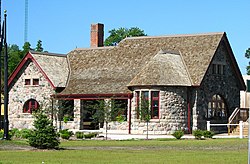|
Standish, Michigan
Standish is a city and the county seat of Arenac County, Michigan. The population was 1,458 at the 2020 census. [4] HistoryThe town was platted by John D. Standish in 1871, who owned all of the land in the vicinity. Before the plat was formally recorded, Standish sold off some of his land in the area. The town was initially named "Granton". John Standish owned the town's first business, a sawmill, he later had the town name changed back to Standish. Jackson and Lansing Railroad reached the community in 1871.[5] The first hotel was built in Standish in 1871 and named The Standish House, by a sheriff of Bay County. The hotel went through several owners before it burned down in March 1902. In 1888 the railroad depot was built by local farmers in the area, each bringing their own materials to help with the construction. In 1898 the State Bank of Standish opened, (now Citizens Bank). Standish was incorporated as a village in 1893 with James Austin as its president, and later a city in 1903, with Mr. H. Randall was as its first mayor. In 1907 Standish got its first automobile dealership, a Buick dealership. By 1912 the city got its first commercial electric lighting for homes and businesses, with power being available between 7 A.M. to Midnight. By 1926 the city was receiving 24-hour electricity service supplied by the Northern Power Company. In 1918, the first gravel road between Pinconning and Standish was built, being a loose dirt road beforehand. The same year that prohibition on alcohol took effect, 1920, three illegal moonshine stills were confiscated by the sheriff, and local arrests were made. By 1938 the population of Standish was 913.[6] The city received the deed to Woodmere Cemetery in 1940. On September 22, 1970 the charter of the city of Standish was adopted, making Standish a home-rule city. GeographyAccording to the United States Census Bureau, the city has a total area of 2.15 square miles (5.57 km2), all land.[7] Standish is located roughly 5.2 miles from the Saginaw Bay. Climate
Demographics
2010 censusAs of the census[11] of 2010, there were 1,509 people, 619 households, and 353 families living in the city. The population density was 701.9 inhabitants per square mile (271.0/km2). There were 682 housing units at an average density of 317.2 per square mile (122.5/km2). The racial makeup of the city was 95.3% White, 0.5% African American, 1.5% Native American, 0.4% Asian, 0.7% from other races, and 1.6% from two or more races. Hispanic or Latino of any race were 2.6% of the population. There were 619 households, of which 30.2% had children under the age of 18 living with them, 36.7% were married couples living together, 14.7% had a female householder with no husband present, 5.7% had a male householder with no wife present, and 43.0% were non-families. 36.7% of all households were made up of individuals, and 16.3% had someone living alone who was 65 years of age or older. The average household size was 2.27 and the average family size was 2.96. The median age in the city was 40 years. 23.6% of residents were under the age of 18; 8.7% were between the ages of 18 and 24; 24.2% were from 25 to 44; 25.7% were from 45 to 64; and 17.8% were 65 years of age or older. The gender makeup of the city was 48.1% male and 51.9% female. 2000 censusAs of the census[2] of 2000, there were 1,581 people, 619 households, and 362 families living in the city. The population density was 738.1 inhabitants per square mile (285.0/km2). There were 672 housing units at an average density of 313.7 per square mile (121.1/km2). The racial makeup of the city was 96.52% White, 0.25% African American, 0.63% Native American, 0.89% Asian, 0.82% from other races, and 0.89% from two or more races. Hispanic or Latino of any race were 2.02% of the population. There were 619 households, out of which 32.1% had children under the age of 18 living with them, 39.4% were married couples living together, 14.2% had a female householder with no husband present, and 41.4% were non-families. 37.5% of all households were made up of individuals, and 20.2% had someone living alone who was 65 years of age or older. The average household size was 2.36 and the average family size was 3.08. In the city, the population was spread out, with 26.2% under the age of 18, 9.2% from 18 to 24, 27.5% from 25 to 44, 19.0% from 45 to 64, and 18.2% who were 65 years of age or older. The median age was 37 years. For every 100 females, there were 82.6 males. For every 100 females age 18 and over, there were 78.4 males. The median income for a household in the city was $22,212, and the median income for a family was $31,719. Males had a median income of $28,523 versus $20,333 for females. The per capita income for the city was $13,608. About 16.4% of families and 19.1% of the population were below the poverty line, including 18.5% of those under age 18 and 14.7% of those age 65 or over. EconomyCorrectional FacilityStandish is home to the state Standish Maximum Correctional Facility, which operated from 1990 through 2009. In late 2009 the facility was briefly considered as a potential United States site for more than 220 prisoners to be relocated from the Guantanamo Bay detention camp, although neighbors and local residents expressed concern and opposition.[12][13][14] At the time, Michigan public officials, including both of its senators (Carl Levin and Debbie Stabenow) and governor Jennifer Granholm, also objected to the idea.[15] InfrastructureMajor highwaysBus
Education
The city of Standish is in the Standish-Sterling Community Schools District. There is one elementary school: Standish-Sterling Elementary located in Sterling. Standish-Sterling Middle School operates in the former Standish-Sterling High School. A new high school, Standish-Sterling Central High School, opened in 2001. External links
References
|
||||||||||||||||||||||||||||||||||||||||||||||||||||||||||||||||||||||||||||||||||||||||||||||||||||||||||||||||||||||||||||||||||||||||||||||||||||||||||||||||||||||||||||||||||||||||||||||||||||||||||||||||||||||||||||||||||||||||||||||||||||||||||||||||||||||||||||||



